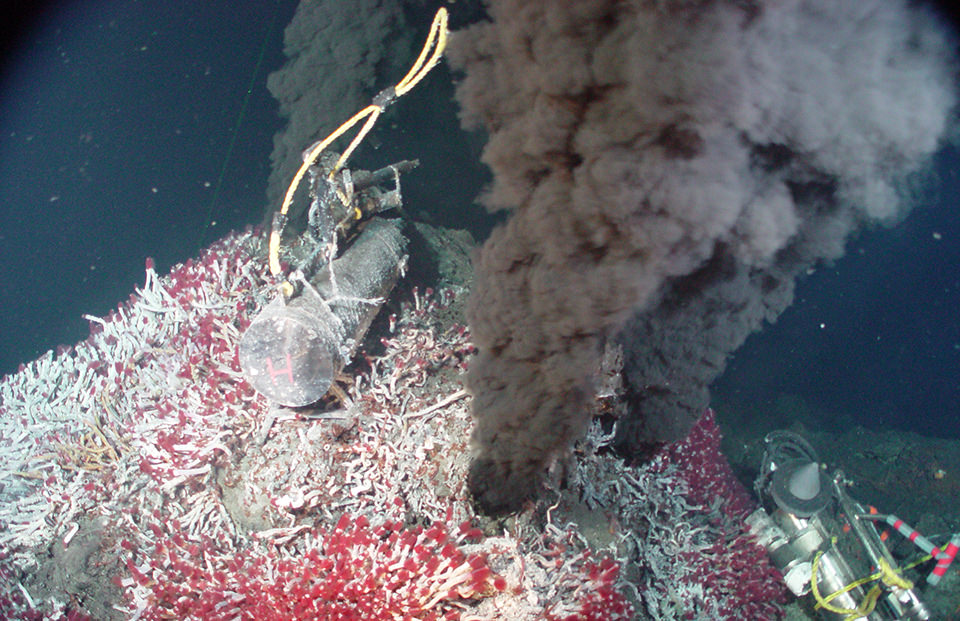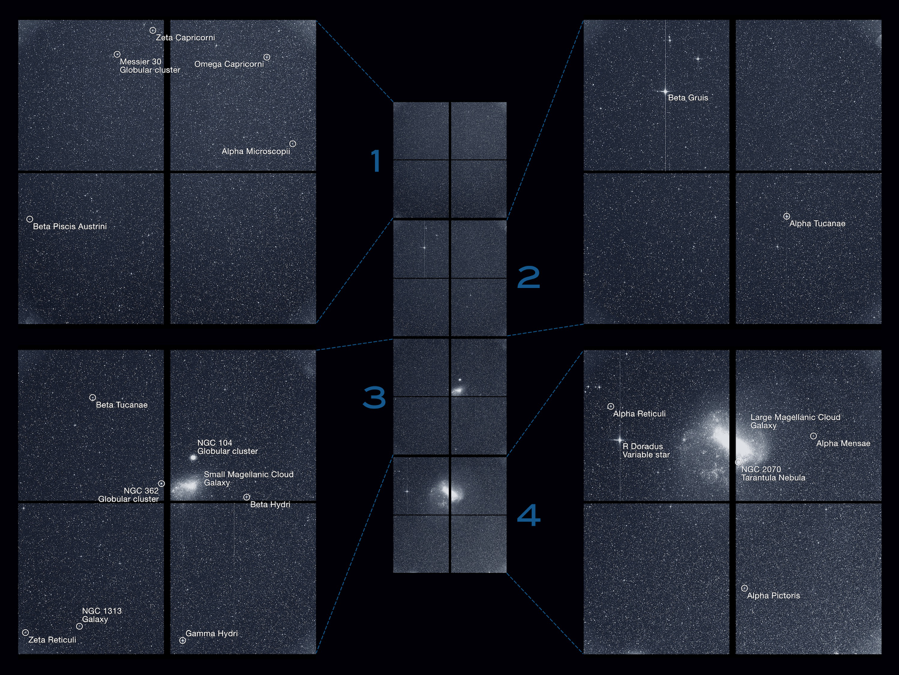TESS: A Satellite Scout for Nearby Exoplanets
December 12, 2018
…and so much more! On August 6, 2018 NASA released a video of a series of images captured by the newly launched Transiting Exoplanet Survey Satellite (TESS). On display is a comet, asteroids, variable stars, and even light reflected from Mars—all just 12 days into the start of its science operations!

An image captured by TESS before the start of its scientific operational period.
Image Credit: NASA/MIT/TESS
About TESS
The Transiting Expolanet Survey Satellite, fondly known as TESS, was conceived in 2006 as a privately funded mission, three years before the Kepler mission was launched. After a number of proposals and re-proposals since 2006, TESS was approved for design in 2013, for implementation in 2014, and completed a critical design review in 2015. TESS is a joint mission with MIT, NASA, Orbital, Harvard-Smithsonian Center, and Space Telescope. Its mission? To find planets orbiting other stars—exoplanets. TESS is mainly on the hunt to identify small planets with bright stars, in hopes that the more powerful James Webb telescope can zoom in for a closer look once it launches, allowing us to learn about the exoplanets’ atmospheres.
During its two year mission TESS will look outward as it orbits around the earth. TESS will observe over 85% of the sky, imaging over 200,000 nearby stars and looking for small drops in light that signal an orbiting exoplanet coming between its star and TESS’s powerful sensors.
TESS has 4 cameras, each covering a 24 degree by 24 degree span of the sky, totaling a 96 degree longitudinal (polar) span and a 24 degree span in latitude (azimuthal). This 96° x 24° span is called a sector. TESS is scheduled to observe each sector for about 27 days, covering first the southern portion of the sky in the first year of its mission, and then the northern portion during its second year. During each year of observing one hemisphere, it constantly gather information over a portion of the polar region, eventually building up a map of 85% of the sky—more than 350 times the portion of sky that the Kepler mission observed!
The very successful Kepler mission’s goal was to find signs of Earth-like planets, and it later turned into the K2 mission as the Kepler probe experienced the loss of a second reaction wheel. The original Kepler mission found 2,244 exoplanet candidates, confirmed 2,347 exoplanets, and confirmed 30 exoplanets that are less than twice Earth’s size and appear to have important characteristics for life. As of May 2018, the later K2 mission had found 493 exoplanet candidates and confirmed 325 exoplanets. The K2 mission ended and the Kepler space telescope began its “goodnight” commands on October 30, 2018, when it ran out of fuel. It’s legacy leaves us with the knowledge that there are many more planets than stars.
Gathering Information from Light & Shadow
So how do we see what’s happening light years away? We can’t get a clear image of the planets orbiting even the closest stars—the stars are too bright, and the planets too small. The trick is in looking for the planets’ shadows: TESS images the stars, recording dips in starlight when an exoplanet drifts between TESS and its star, allowing scientists to determine the size of the planet based on how much light is blocked. The exoplanet’s gravity can also pull its star slightly in one direction or another as it orbits around—and by making observations of how the starlight is Doppler shifted (shifted to longer or shorter wavelengths) by this wobbling, scientists can determine the mass of the planet.
Knowing the mass and the size of a planet allows scientists to determine its density, an important piece of information that lets us know, for example, whether it is made of rocky material, like the first four planets in our solar system, or mostly of gas, like Jupiter and Saturn. Knowing a planet’s mass and how long it takes to make an orbit, scientists can determine how far the planet is from its star, and by looking at velocity curves they can determine the eccentricity (how elliptical) its orbit is. The distance from a planet to its star is important in determining whether or not it is in the habitable zone—a range where liquid water might be present on the surface.
A Casting Call for Earthlike Planets
The possibility of liquid water on a planet’s surface is a good start (although it might not be necessary), but there are a lot of other things that can make a planet seem like a promising home for life as we know it. For instance, the mass of the planet determines its gravity, which is necessary to hold down an atmosphere. A planet’s size also influences how hot its core is, and how geologically active we can expect it to be. An active core usually has a liquid region that produces a planetary magnetic field that can protect a planet’s atmosphere from the solar wind, energetic charged particles that stars produce. The solar wind can strip away a planet’s atmosphere if it becomes geologically inactive. Mars, for example, is not so geologically active now—but it was in the past. There is clear evidence that there was once a significant atmosphere on Mars that supported a water cycle much like Earth’s. There are dried up river beds, layered sediments, and evidence of erosion from water, as well as signs of past geologic activity. But Mars is no longer very geologically active. Its lithosphere (the rigid top layer containing the crust and upper mantle) is believed to go almost to its core. Mars’ magnetic field is extremely weak, and the energetic particles emitted by our Sun tear away at its now tenuous atmosphere.
Geological activity can also provide a secondary power source that could allow a planet to develop life, even if the world isn’t in the classic habitable zone of its star. From the surface, the moon Europa seems to be an ice-world, but evidence suggests it has a liquid water interior, kept warm by an active, rocky core. This kind of activity could produce hydrothermal vents, like the kind that sustain communities of strange-looking organisms in the depths of Earth’s oceans

A hydrothermal vent at the ocean floor is surrounded by strange-looking tube worms.
Image Credit: NOAA
The Webb Followup
The James Webb Telescope, scheduled to launch in 2021, will follow up on TESS’s findings. It will focus in on exoplanets found in the areas of the sky that are under constant watch by TESS in its polar regions of view. One of the Webb Telescope’s goals is to determine atmospheric properties of exoplanets of interest. Again, the shadows of planets are our friend here: To determine what the atmospheres are like, the Webb telescope will look at starlight passing through the planet’s atmosphere as it transits in front of its star. Every atom or molecules absorbs a unique set of wavelengths of light, providing a "fingerprint” to identify it. Indications of nitrogen, oxygen, water, and carbon dioxide would tell us that a planet’s atmosphere is something like Earth’s, while an abundance of carbon dioxide with sulfuric acid clouds could indicate a runaway greenhouse effect leading to an atmosphere like Venus’. Hydrogen and helium, with some hydrogen compounds such as ammonia or methane thrown in would indicate that we’re looking at a planet like the outer gas giants in our solar system. A planet’s surface temperature can also be ascertained by monitoring the amount of infrared radiation detected: Planets emit infrared radiation, but as a planet moves behind its star in our field of view, the amount of infrared radiation observed dips. This dip provides information about the infrared radiation being emitted by the planet, which translates to information about its surface temperature, and further supports measurements of its size and orbital period! Other telescopes, such as Spitzer Space Telescope, could obtain this type of information to improve the priorities and efficiency of viewing time that the Webb looks at objects.
[What] We've Seen So Far
What has TESS already found even before its big scientific data crunching debut? Watch the embedded video to learn about the amazing observations already made, and the promise this new survey satellite has in store for us. It consists of a compilation of images taken on July 25, 2018 by the Transiting Exoplanet Survey Satellite (TESS). The angular extent of the widest field of view is six degrees. The video shows comet C/2018 N1, asteroids, variable stars, asteroids and light that is reflected from Mars.
What's to Come?
Keep your eyes open for TESS in the news. This survey satellite promises not to disappoint! Here’s an image it took with its four cameras during a 30 minute period on August 7, 2018.

(Click to enlarge)
Image Credit: NASA/MIT/TESS
References and Resources
NASA’s Planet-Hunting TESS Catches a Comet Before Starting Science, NASA, 6 Aug 2018
NASA’s TESS Shares First Science Image in Hunt to Find New Worlds, NASA 17 Sep 2018
Transiting Exoplanet Survey Satellite website
James Webb Space Telescope website
J. Bennett, M. Donahue, N. Schneider, and M. Voit, The Cosmic Perspective 8th ed., Pearson, New York, (2018).
—H.M. Doss














